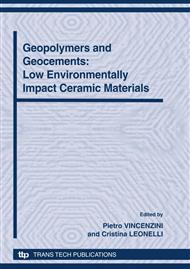[1]
J. Davidovits, Chemistry and Applications, 19-36 (2008).
Google Scholar
[2]
H. Xu, Geopolymerisation of Aluminosilicate Minerals, PhD Thesis, Department of Chemical Engineering, University of Melbourne, Australia, (2001).
Google Scholar
[3]
M.W. Grutzeck and D. D Siemer, Zeolithes Synthesised from Class F Fly Ash and Sodium Aluminate Slurry, J. Am. Ceram. Soc., 80 (9), 2449-2458, (1997).
DOI: 10.1111/j.1151-2916.1997.tb03143.x
Google Scholar
[4]
Z. Li, Y. Zhang and X. Zhou, Short Fiber Reinforced Geopolymer Composites Manufactured by Extrusion, Journal Materials in Civil Engineering, vol 17(6), 624-631, (2005).
DOI: 10.1061/(asce)0899-1561(2005)17:6(624)
Google Scholar
[5]
J. P. Wu, A.R. Boccaccini, P.D. Lee and R.D. Rawlings, Thermal and Mechanical Properties of a Foamed Glass Ceramic Material Produced from Silicate Waste, Eur. J. Glass Sci. Technol. A, 48 (3), 133-141, (2007).
Google Scholar
[6]
V. Barbosa and K. Mackensie, Synthesis and Thermal Behaviour of Potassium Sialate, Mater. Letters, 57, 1477-1482, (2003).
DOI: 10.1016/s0167-577x(02)01009-1
Google Scholar
[7]
J.L. Bell and W.M. Kriven, Preparation of ceramic foams from metakaolin-based geopolymer gels, Ceramic Engineering and Science Proceedings, 29 (10), 97-112, (2009).
DOI: 10.1002/9780470456200.ch10
Google Scholar
[8]
T. Jettner, H. Moertel, V. Svinka and R. Svinka, Structure of kaoline-alumina based foam for high temperature applications, J. of European Ceram. Soc., 27, 1435-1441, (2007).
DOI: 10.1016/j.jeurceramsoc.2006.04.029
Google Scholar
[9]
H.R. Fernandes, D.U. Tulyaganov, J.M.F. Ferreira, Preparation and characterization of foams from sheet glass and fly ash using carbonates as foaming agents, Ceram. Inter., 35, 229-235, (2009).
DOI: 10.1016/j.ceramint.2007.10.019
Google Scholar
[10]
P. Duxson, G. C. Lukey, and S. J. Van Deventer, Thermal Conductivity of Metakaolin Geopolymers Used as a First Approximation for Determining Gel Interconnectivity, Ind. Eng. Chem. Res., 45, 7781-7788, (2006).
DOI: 10.1021/ie060187o
Google Scholar
[11]
E. Prud'homme, P. Michaud, E. Joussein, C. Peyratout, A. Smith, S. Arri-Clacens, J.M. Clacens, S. Rossignol, Silica fume as porogent agent in geo-materials at low temperature, Journal of the European Ceramic Society, 30, 1641-1648 (2010).
DOI: 10.1016/j.jeurceramsoc.2010.01.014
Google Scholar
[12]
J. Davidovits, Synthetic Mineral Polymer Compound of the Silicoaluminates Family and Preparation Process, US Patent, 4, 472, 199, (1984).
Google Scholar
[13]
P. Innocenzi, Infrared Spectroscopy of Sol-Gel Derived Silica-Based Films: a SpectraMicrostructure Overview, Journal of non crystalline solids, 316, 309-319, (2003).
DOI: 10.1016/s0022-3093(02)01637-x
Google Scholar
[14]
M. Criado, A. Polomo and A. Fernandez-Jiménez, Alkali Activation of Fly Ashes, Part 1: Effect of Curing Conditions on the Carbonation of the Reaction Products, Fuel, 84, 2048-2054, (2005).
DOI: 10.1016/j.fuel.2005.03.030
Google Scholar
[15]
J. Davidovits, Scientific Tools, X-rays, FTIR, NMR, Geopolymer: Chemistry and Applications, 61-76, (2008).
Google Scholar
[16]
W. K. W. Lee and J. S. J. Van Deventer, Use of Infrared Spectroscopy to Study Geopolymerization of Heterogeneous Amorphous Aluminosilicate, Langmuir, 19, 8726-8734, (2003).
DOI: 10.1021/la026127e
Google Scholar
[17]
C. A. Rees, J. L. Provis, G. C. Luckey and J. S. J. Van Deventer, Attenuated Total Reflectance Fourier Transform Infrared Analysis of Fly Ash Geopolymer Gel Aging, Langmuir, 23, 81708179, (2007).
DOI: 10.1021/la700713g
Google Scholar
[18]
T. Uchino, T. Sakka, K. Hotta and M. Iwasaki, Attenuated Total Reflectance Fourier-Transform Infrared Spectra of a Hydrated Sodium Silicate Glass, J. Am. Ceram. Soc., 72 (11), 2173-2175, (1989).
DOI: 10.1111/j.1151-2916.1989.tb06051.x
Google Scholar
[19]
Y.I. Jialiang, IR Studies of Alkali Silicate Glasses, Journal of Non-Crystalline Solids, 52, 211215 (1982).
Google Scholar


